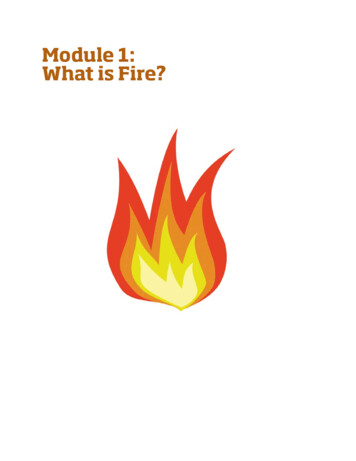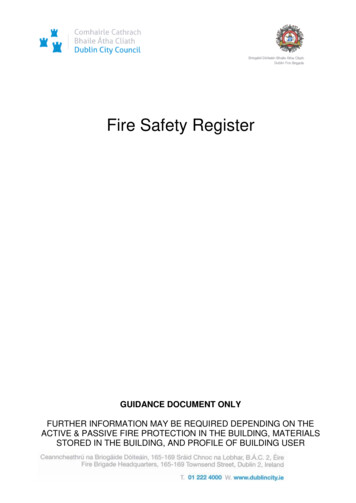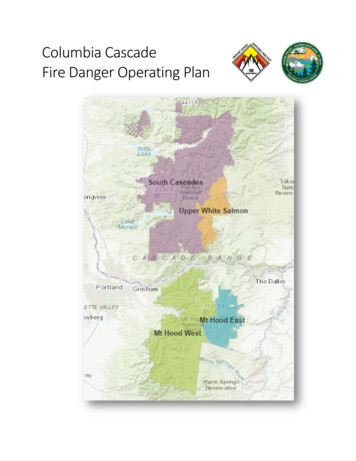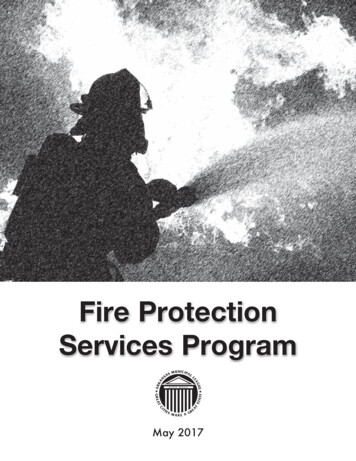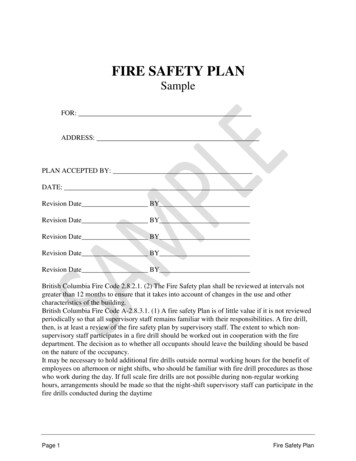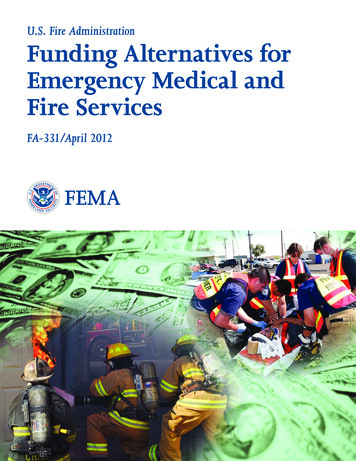
Transcription
U.S. Fire AdministrationFunding Alternatives forEmergency Medical andFire ServicesFA-331/April 2012
U.S. Fire AdministrationMission StatementWe provide National leadership to foster a solid foundation for our fire and emergency services stakeholders inprevention, preparedness, and response.
This page intentionally left blank.
PrefacePrefaceThe U.S. Fire Administration (USFA) would like to acknowledge the U.S. Department of Homeland Security’s (DHS’s) Office of Health Affairs for providing the substantial support necessary to perform this researchand to develop this report.This report was prepared through a cooperative agreement between the USFA and the International FireService Training Association (IFSTA) at Oklahoma State University (OSU). IFSTA and its partner OSU FireProtection Publications has been a major publisher of fire service training materials since 1934 and, throughits association with the OSU College of Engineering, Architecture, and Technology, it also conducts a varietyof funded technical research on fire and emergency services and fire and life safety issues.The extensive information provided in this report would not have been possible without the dedication andefforts of the following people assigned to this project: Project Administrator—Nancy J. Trench, Assistant Director for Research, Fire Protection Publications, OSU; Principal Investigator/Project Manager—Michael A. Wieder, Executive Director, IFSTA; Editor and Proofreader—Cindy Finkle, Research Assistant, Fire Protection Publications, OSU; Principle Writer—Scott Somers, FACETS LLP; and Principal Researcher—Kevin M. Roche, FACETS LLP.The content of this report was reviewed by a group of subject matter experts (SMEs) and organizational representatives who have extensive knowledge and interest in this topic. The USFA and DHS’s Office of HealthAffairs would like to thank the following individuals and organizations for providing this oversight: Bill Troup—USFA; Richard Patrick—DHS, Office of Health Affairs; Dr. Jeffrey Lindsey, Ph.D.—Assistant Fire Chief, Alexandria Fire Department, VA; Bruce Evans—Emergency Medical Services (EMS) Chief, North Las Vegas Fire Department, International Association of Fire Chiefs (IAFC) Liaison to the National Association of EMS Physicians(NAEMSP); Mark Light—Executive Director/Chief Executive Officer (CEO), IAFC; Sean Caffrey—Interim EMS Operations Program Manager, EMTS Section, Colorado Department ofPublic Health and Environment; Philip Oakes—National Program Director/Trainer, National Association of State Fire Marshals (NASFM); Dennis Mitterer—MS, BSN, Emergency Medical Technician-Paramedic (EMT-P); Ronny J. Coleman—Representative for the National Volunteer Fire Council (NVFC); Dr. Lori Moore-Merrill—Assistant to the General President, International Association of Fire Fighters (IAFF); and Catherine Patterson—Branch Chief, Assistance to Firefighters Grants, Federal Emergency Management Agency (FEMA).i
This page intentionally left blank.ii
Table of ContentsTable of ContentsChapter 1: Introduction .1Chapter 2: About This Manual .3Local Revenue and Funding Alternatives .3State and Federal Funding Programs .4Private-Sector Sources .4Writing an Effective Grant Proposal .5Implications of Funding Choices .5Scope.5Sources of Information.6Summary .6Chapter 3: Writing an Effective Grant Proposal .9Grant Fundamentals .9Basic Components of a Proposal . 10Where to Get Help . 15Interaction and Networking . 16Books on How to Write a Grant Proposal. 18Help for Nonprofit Organizations . 19Where to Find Help on the Internet . 19Chapter 4: Local Revenue and Funding Alternatives .23Sources of Local Revenue .23Development Impact and User Fees. 26Fines, Forfeitures, and Penalties . 32Enterprise Funds and Utility Rates .34Sale of Assets and Services .34Benefit-Assessment Districts . 35Borrowing. 37Entrepreneurial Emergency Medical Services . 39Cost-Saving Strategies . 42Nontraditional Fundraising Ideas . 45Chapter 5: State Funding for Emergency Medical Services .49State Sources of Revenue .49State-Managed Federal Grants. 51Specific State Grants and Aid Programs .53Alabama. 53Alaska . 53iii
Table of ContentsArizona . 55Arkansas . 55California . 57Colorado . 59Connecticut . 60Florida . 61Georgia . 62Hawaii. 62Idaho . 62Illinois .64Indiana . 65Iowa . 65Kansas . 66Kentucky . 66Maine . 67Maryland. 67Montana. 68New Mexico . 68North Carolina . 69North Dakota . 70Ohio . 70Oklahoma. 72Oregon . 73Pennsylvania. 73Tennessee . 74Texas . 74Utah. 75Virginia. 76Washington. 79Wisconsin . 80Wyoming . 82Chapter 6: Federal Funding for Emergency Medical Services and Fire Agencies .85Federal-Funding Basics .85Types of Federal Grants .85Data Universal Numbering System Number .86Federal Grants .86Chapter 7: Foundations and Corporate Grants . 103Foundations . 103Common Types of Foundation Grants . 104iv
Table of ContentsCorporate-Giving . 105Program-Related Investments . 106Philanthropy and Private Grants . 106Appendix A: Successful Grant Application Example. 117Appendix B: State Emergency Medical Services Offices . 137Appendix C: State Fire Marshal Offices . 143Appendix D: State Homeland Security Contacts . 149Appendix E: State Emergency Management Agencies . 155Appendix F: Success Stories . 161v
This page intentionally left blank.vi
IntroductionChapter 1: IntroductionEmergency medical services (EMS) departments and fire departments provide invaluable services in theircommunities. In the United States, EMS agencies and fire departments respond to millions of calls forservice each year.1 Service expectations placed on EMS and fire services organizations, including the fireservice’s role in EMS delivery, response to natural disasters, hazardous materials incidents, technical rescue,and acts of terrorism, have steadily increased.This expanding mission comes at a time when local government budgets are stretched increasingly thin,which translates into more duties with fewer dollars to support them. A needs-assessment survey, conducted by the U.S. Fire Administration (USFA) in cooperation with the National Fire Protection Association(NFPA), documents a concerning lack of appropriate training, as well as inadequate facilities and equipmentnecessary to maintain basic fire and EMS response capabilities among the U.S. fire service, particularly inrural and volunteer fire departments. Few departments have the capability to handle unusually challengingevents, such as wildland urban interface (WUI) fires, hazmat, or major floods.Striking the right balance between different sources of local revenue has become an essential skill for EMSand fire administrators and chief officers. So, too, has the ability to identify and acquire grants and otheralternative revenues.To meet this critical need and serve its constituents regarding effective methods for obtaining funding, USFAdeveloped the publication, Funding Alternatives for Fire and Emergency Services in 1993 and completed an update andrevision of this document in 1999. This has been one of the USFA’s most popular publications with thousands of copies being distributed and downloaded from the USFA website. In 2009, supported by the Department of Homeland Security (DHS) Office of Health Affairs, the USFA partnered with the InternationalFire Services Training Association (IFSTA) to update and revise the December 1999 edition of the report inorder to provide the most up-to-date information regarding sources of funding for local-level EMS agenciesand fire departments.A key part of the project initiative was an enhanced study of critical funding issues for both fire and nonfire-service-based EMS systems. EMS is an essential public service in local communities. When illness orinjuries strike, citizens depend upon EMS to respond with timely, high-quality care. According to the Institute of Medicine (IOM), more than 16 million patients arrive at the emergency room by ambulance eachyear. Even more are treated onscene without transport. A significant challenge for EMS is to ensure stableand sufficient revenue to provide for adequate prehospital care of the sick and injured. An optimal level ofservice in EMS typically presupposes revenue from more sources than taxpayer funding alone.EMS agencies and fire departments require funding for expenses such as equipment, training, and salaries inorder to provide necessary protection to their respective communities. However, with tighter budgets, lessgovernment subsidies, and fewer donations, it is becoming increasingly more difficult for EMS agencies andfire departments to meet greater and more complex demands for its services.However, there have been many recent changes in the availability of Federal funding for EMS agencies andfire departments, including the Firefighter Investment and Response Enhancement (FIRE) Act, the Staffingfor Adequate Fire and Emergency Response (SAFER) Act grant program(s), as well as other important grantprograms. This updated document includes sources of Federal funding as well as other new and innovativefunding sources not discussed in previous editions.1“Fire in the United States 2003–2007,” 15th ed. USFA. October 2009.1
This page intentionally left blank.2
About This ManualChapter 2: About This ManualThe purpose of this manual is to identify the various grants and innovative funding alternatives available foremergency medical services (EMS) and fire protection services. Where appropriate, a discussion of the prosand cons of a particular funding source is discussed. In some instances, examples are given to illustrate howalternative funding is being successfully implemented in EMS agencies and fire departments across the country.This report is divided into the following several major sections identifying various sources of availablefunding and revenue options.Local Revenue and Funding AlternativesThe funding alternatives available at the local level vary widely, though the ability of the EMS administrator or fire chief to influence changes in these sources will vary considerably based on local preferences andState and local laws. Many enterprising departments have found new revenue streams through the sale ofservices. The discussion of local revenue sources includes Taxes: These include taxes on real property, personal income, and sales transactions. Other taxesinclude real estate-transfer taxes and utility-user taxes. New taxes can go into a city’s general fundto be divided up by elected officials or can be earmarked specifically for EMS and fire services. Development Impact and User Fees: These fees are charged to ensure that those benefitting froman activity pay their fair share of the costs related to that activity. Fines, Forfeitures, and Citations: Some jurisdictions now issue citations to those who engage inhigh-risk activities that may later require a rescue. Other areas dedicate a portion of fines to fundEMS and fire services. Enterprise Funds and Utility Rates: Local governments may establish an enterprise fund for cityoperated services. Ambulance service, for example, may be run like a municipal business where it isexpected to earn revenue to support its operations. Sale of Assets and Services: Some EMS and fire agencies sell used equipment or services to producerevenue. Benefit Assessments: Special districts may be established for the purpose of supporting EMS andfire services. These districts can assess a benefit assessment similar to a property tax but based onthe “benefit” received by each property. These charges are a way to circumvent property-tax limitations and can also improve the equity of charges for EMS. Borrowing: Cities and towns have a number of options for borrowing revenue needed to purchasecapital equipment and facilities including General Obligation bonds and Certificates of Participation.Not-for-profit organizations may have access to low-cost 501(c)(3) revenue bond financing or maytake out a traditional bank loan.This section also discusses creative ways fire chiefs and EMS administrators have raised revenue for theiragency such as creating private ambulance company contracts to reimburse for fire-based EMS, billing fordepartment-operated ambulance services, offering subscription programs, providing interfacility transport,creating paramedic intercept agreements with surrounding communities, and piloting innovating healthcare programs. The section concludes with time-tested cost-saving strategies and miscellaneous fundraisingideas for rural and volunteer fire and EMS agencies.3
Chapter 2State and Federal Funding ProgramsIn addition to sources of local revenue derived from taxes and other local government financial mechanisms,EMS agencies and fire departments may be able to obtain considerable funding from State and Federal programs. Two chapters list grants available from States and the Federal government.Often, Federal grant funding flows to the local level through the States. However, some States provide direct funding for EMS, especially in rural areas. Many States offer grant aid and low-interest loans for capitalimprovement projects. On the other hand, some States have no funding for local programs. Most StateFire Marshal’s Offices and EMS bureaus offer technical assistance to local agencies and subsidized trainingprograms to first responders.EMS administrators and fire chiefs in States without funding may wish to consider what other States are doing and determine if some of those methods might be feasible in their State. The taxpayers pay for EMS oneway or the other, but some approaches may be more palatable or more equitable than others.Agencies of the Federal government offer thousands of grants and special programs to State and local governments; many of them may apply to EMS. Some programs are not specifically earmarked for fire or EMSbut can be used for those purposes, such as community block grants.Private-Sector SourcesPrivate foundations and corporate-giving programs donate millions of dollars annually for education, arts,and community development, among other projects and programs. Career and volunteer EMS and fire agencies may be able to raise funds for capital purchases or to improve service delivery through these sources,especially in rural communities or poor urban areas. When looking at these options, caution should be takento ensure that accepting donations from these types of programs does not result in the appearance of a corporate preference or conflict of interest. This is of particular importance for EMS and fire organizations thatare government-funded. This is of lesser concern for volunteer organizations that operate outside the directcontrol or funding of their local government. Some public EMS and fire departments establish separate 501(c)(3) nonprofit organizations to accept donations for local causes related to their mission. Among the privatesector sources of giving are Foundations: Some communities are fortunate to have community/public foundations whose fundscan be used for providing special public safety services, starting new programs, helping low-incomeareas, or other services allowed by charter. There are also national independent and corporate foundations that donate to communities across the country. Foundations provide a source of revenuethrough general operating support grants, planning grants, seed money, management assistancegrants, and facilities and equipment grants. Corporate-Giving: Many public safety agencies have been successful in soliciting grants and services from national corporations. Companies are often interested in providing community assistancein cities and towns where they have a corporate presence or where their employees live. Corporategiving has public relations benefits and emergency service administrators should be ready and willing to recognize corporate sponsors whenever possible. Corporate-giving comes in the form of cashdonations, in-kind contributions, and even executive loan programs. Program-Related Investments: In addition to grants, cash, or in-kind donations, foundations andcorporations may be a source of low-interest or zero-interest loans, particularly for capital-improvement projects.4
About This ManualWriting an Effective Grant ProposalThe final chapter of this manual presents fundamentals of developing grant proposals to assist EMS administrators and fire officers in preparing appropriate documentation in pursuit of grants from government and privatesources. While this advice is generally applicable to any grant application, grant seekers must always read, understand, and follow the specific program guidelines for grant opportunity.Implications of Funding ChoicesEach agency providing EMS and fire protection must consider the range of opportunities and the local andState constraints in shaping its funding policy and determining its budget. Funding influences the amountof response resources available and the scope of preventative activities which, in turn, influences patientoutcomes. The funding issue is not one to be left solely to accountants and financial officers; it is a vitalpublic policy issue that deserves community input.The choice of funding approaches also raises fundamental questions about governance and equity. Manyquestions about EMS have become part of the larger national health-care debate: Is EMS solely a privategood where users of prehospital medical services pay for the burden of the services provided to them? Or,is EMS a public good provided by the community to people in need, and the cost spread across society? Perhaps EMS should be treated like insurance, in which the fees charged are a function of the risk presented?Who should provide EMS?These are fundamental questions about our values and the role of government in society and apply to the fireservice as much as they do EMS or any service the government provides. Different communities are takingradically different approaches; many seem uneasy about charging for services beyond the taxes paid, whileothers have found it to be the only way to fund critical public safety services.Providers of emergency services should consider the wide variety of funding alternatives available to financeservices and perhaps improve the equity of paying for the service. Citizens often balk at new fundraising mechanisms. Changing the way public safety is funded can profoundly affect the way government isviewed, and change the unwritten contract between a government and its citizens on major issues such asrepresentation and the purposes and goals of government. EMS and fire leaders must take a collaborativeand participatory approach to addressing complex public policy issues, including discussions about the roleof EMS and fire agencies in the community and how public safety services are funded.Finally, local government charters and State constitutions may limit the extent to which EMS agencies andfire departments can generate revenue. Some States prohibit volunteer ambulance agencies from billing forservices. Others have restricted the amount of development impact fees that can be charged and prohibitedthe adoption of new user fees. Before developing any new cost-recovery program, EMS managers shouldconsult with an attorney to discuss any limitations.ScopeThis manual discusses alternative sources of revenue available to fund EMS and fire protection in all types ofsystems: career or volunteer, urban or rural, advanced life support (ALS), or basic life support (BLS). Whilefire-based EMS agencies and private-sector ambulance companies are an important part of many systems,some of the grants and funding sources contained herein apply only to the fire service. The fire service isthe primary first responder in many communities and many fire departments play a major role in providingEMS. Currently, fire departments with cross-trained dual-role personnel constitute 38 percent of EMS responders in the United States, more than any other single-system type.2 Many of the Federal grants autho2“EMS By the
These include taxes on real property, personal income, and sales transactions. Other taxes include real estate-transfer taxes and utility-user taxes. New taxes can go into a city's general fund to be divided up by elected officials or can be earmarked specifically for EMS and fire services. Development Impact and User Fees:



